- asana.sk - yoga courses
- akademiakrasy.sk - online yoga at home
- yogajournal.com - more about different yoga exercises
Yoga, the medicine for body and soul: how to start? (Basic exercises and positions)

Photo source: Getty images
Yoga is perceived in the Western world primarily as a physical exercise. But the truth is that as a meditation practice it has a much deeper meaning.
Article content
Yoga as such is a philosophical-religious movement and meditation practice. It originated in ancient India.
The physical exercises of yoga, called asanas, are used to purify the body and mind.
It acts as a medicine for the body and mind.
As a system of Indian philosophy, yoga considers the perfection of the body and the sensory organs as important. Therefore, meditation is done through physical exercises. In this way, they complement each other and in a sense perfect the body and mind.
The history of yoga
According to known facts, the origins of yoga date back to around 3500 B.C. This is confirmed by excavations in the Indus basin. At that time, artefacts depicting figures in yoga postures were found there.
However, the age of yoga itself is not precisely known.
Europeans recognised it at the time of the colonisation of India by the English and French.
The meaning and purpose of yoga
If we want to take yoga seriously, we need to know its deeper meaning.
It is said that the purpose of yoga is to liberate the soul from matter. By matter is to be understood the physicality of man. The soul is to be brought to a state of pure consciousness.
It strengthens the body and mind to achieve a balanced behaviour and a firm personality.
Yoga seems to have a really deep significance for the body and soul of man.
How to perform it, you ask?
Yoga knows the concept of psychophysiology.
Its aim is to learn self-control and improve the body and psyche.
Meditation, asceticism and physical exercises are the basic means to improve the body and soul.
How to get started?
Yoga and its types
Basic exercises
Yoga and its effects
Yoga heals. How to get started?
Only an experienced yoga teacher can ensure that we practice correctly.
So the very first step is to sign up for a beginner's course.
We will be under expert supervision.
The aim of the exercises is not to master them perfectly. That, of course, will come with time.
The main way to gain flexibility is through breathing and the correct transmission of prana.
Prana is life energy. It manifests at different frequencies and in different forms. One of them is breathing.
Yoga practice is approached holistically. The body needs to be brought into harmony with the spirit and soul at the same time.
To this end, yoga uses a series of exercises, called kriyas. These are both static and dynamic and alternate with phases of relaxation.
Yoga aids are also used in the practice of yoga:
- straps
- cushions
- chairs
- yoga mats
- yoga mats
- various rollers or wheels, etc.
They serve as aids for staying in certain postures. They also stabilize the body for health problems during yoga therapy.
Types of yoga
There are several types of yoga, but not all of them are suitable for beginners.
In any case, any kind of yoga will seem strenuous at the beginning.
Let's take a closer look at some of them.
Ashtanga yoga
This is just the type of yoga that would probably not be advisable to practice right at the beginning.
It consists of eight stages of exercises created by the Indian philosopher Patanjali.
The physical exercises aim at the correct channeling of energies. Mental meditation, on the other hand, seeks to achieve the recognition of one's identity with universal consciousness.
The following table lists the different stages of Ashtanga Yoga, what they consist of and their respective names
| Degree | Name | Meaning of the exercise |
| I. | Yama | Psycho-hygiene lessons on how to behave towards the environment |
| II. | Niyama | Lessons on self-education |
| III. | Asana | The physical exercise itself |
| IV. | Pranayama | Breathing exercises and breath control |
| V. | Pratyahara | Mental exercises to distract the mind from the distractions of the bodily senses |
| VI. | Dharana | Exercises to increase concentration |
| VII. | Dhyana | Meditation, contemplation |
| VII. | Samadhi | State of pure consciousness |
Power Yoga
It is suitable for beginners.
It contains more physical than mental exercises. It focuses on stretching and rehabilitation of the physical side.
It is very popular among people.
It focuses on exercises with the weight of one's own body.
It has a positive effect against back pain and helps in eliminating bad movement habits.
It releases muscular and mental tension, increases energy, physical strength and flexibility.
Hatha Yoga
It is the most widespread in the western world.
It is mainly used to develop physical health. It practically consists of the first five stages of Ashtanga yoga.
These consist of physical exercises.
These exercises connect the body and mind in a certain way. The aim is to bring the opposing forces of the body into harmony. The body must first rid itself of the disorders it has acquired through poor living and superficial breathing.
Hatha yoga has some of the most elaborate exercises. It works on the musculoskeletal system, the central nervous system and the internal organs.
Sahaja Yoga
Translated it means "natural connection".
This type of yoga is widespread in at least 105 countries around the world.
It is used in both medicine and art.
It is a meditation technique in which kundalini energy is awakened. This happens in the very first meditation.
This energy manifests on the head and hands. It is felt as a gentle, cooling breeze.
Knowing our inner consciousness or self-realization is what we are to realize during the practice of Sahaja Yoga.
Kundalini Yoga
This type of yoga has very great uses.
It works to increase the kundalini power in our body. This energy is stimulated by different body movements and combinations of different postures.
The exercises are suitable for every age group. For people with physical limitations and for people in different mental states.
It uses various breathing exercises, chanting mantras, meditation, relaxation exercises and physical exercises.
The results come quite quickly with this type of yoga.
The goal is to achieve a connection with higher consciousness. Detachment from one's own ego and gaining the ability to look at things with detachment.
Basic yoga exercises
Yoga uses a series of exercises called kriyas.
These consist of static or dynamic asana exercises. They are combined with phases where the body and mind are completely relaxed.
Asanas are the basic elements of yoga practice. Their purpose and meaning is to assume a particular body position and feel relaxed in it for a period of time.
We are familiar with these basic types of asanas:
- bowing
- bowing
- bowing
- rotational
- inverted
- balance
These are the exercises we should encounter most often in our yoga practice.
Tadasana - mountain
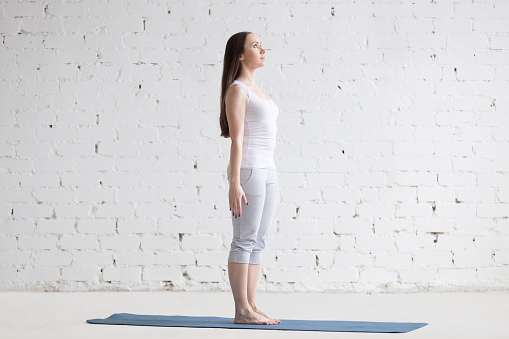
Stand upright with your feet together. Weight is transferred evenly to both feet. Pull yourself to your head while straightening your spine. Breathing is calm and fluid.
Adho Mukha Svanasana - downward looking dog
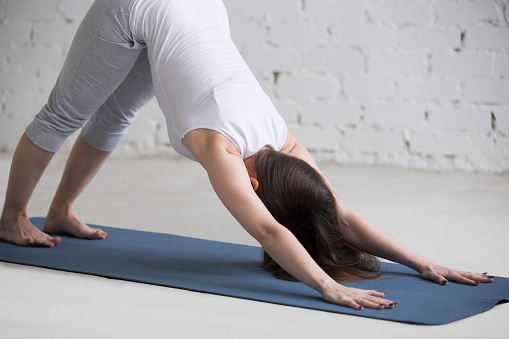
From a supine posture as in a traditional push-up, gradually raise the buttocks upwards. Keep the palms and feet flat on the mat.
If we find it difficult to straighten our legs at first, we can keep our knees bent. Spread our toes apart.
Take your hands off the ground and stretch your back backwards.
This exercise has a calming effect on our mind. This is due to the position of the head below the level of the heart.
Plank
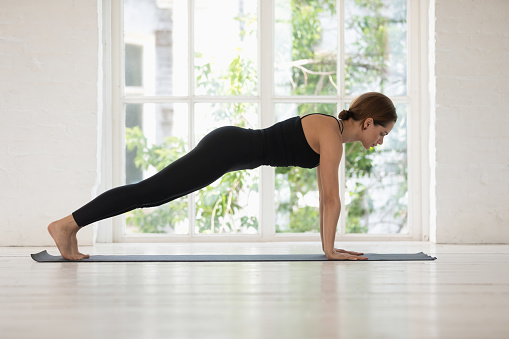
We start this exercise from the downward looking dog position.
This time, however, we keep the buttocks in line with the whole body.
From head to toe.
Leaning on outstretched arms and toes. Heels as close together as possible, palms the same.
Firm the back and draw the belly in.
The best exercise to strengthen the whole body. Especially the core.
Read more about how to perform the plank.
Urdhva Mukha Svanasana - upward looking dog
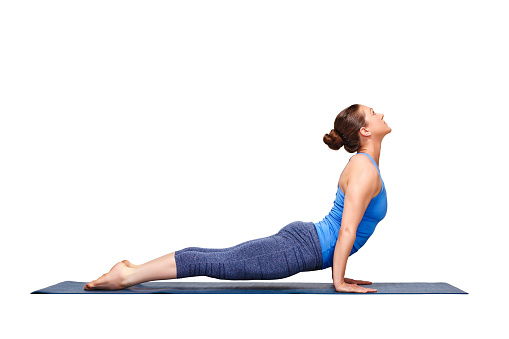
Lie on your stomach face down. Rest your hands on the mat in the lower chest area, place your whole palms on the mat. Gradually use them to push out your upper body.
Get into a position where the lower body is on the mat and the upper body is almost perpendicular to the mat. The hands are still resting on the mat.
Gradually lift your thighs and knees off the mat. If you can do this, rest only the outside of your feet and the palms of your hands on the mat.
Utkatasana - chair position
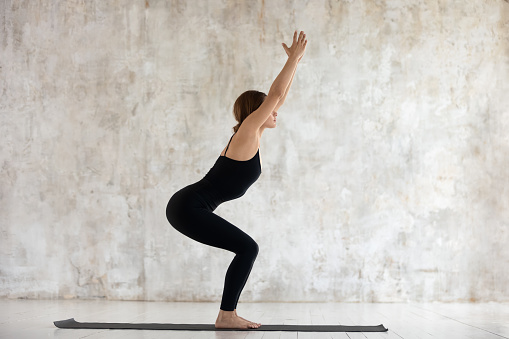
Stand upright on the mat. Stand up, i.e. raise the arms up along the head. Turn the palms inwards.
Slowly, as if to sit on a chair.
But there isn't one.
We put our weight on our heels and try to stretch our body up and forward.
This exercise strengthens the shoulders, legs and back.
Virabhadrasana - warrior
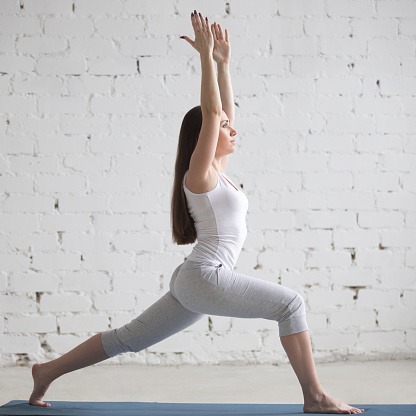
We start in a standing position, with the feet about shoulder width apart.
Step backwards with one foot, resting it on its toe. Then drop slightly so that the thigh of the front foot is parallel to the mat.
Stand up with the palms facing each other. The head is in a normal position, the gaze is fixed in front of you.
Later we can change the position of the legs.
This exercise will calm our mind.
Vrksasana - tree
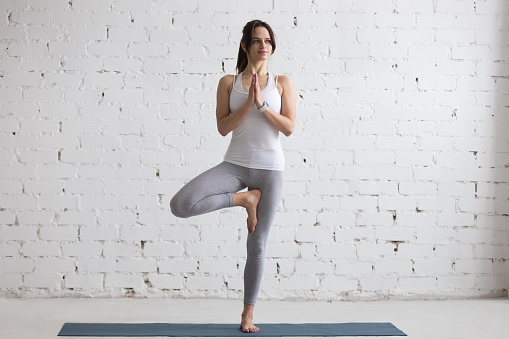
We start the posture standing upright.
At the same time, we try to use our hands to bring the sole of one foot into such a position that it rests on the inner thigh or calf of the other leg.
How high?
That depends on our flexibility.
There's only one condition. The foot must not rest on the knee. So we don't injure it.
Later, we can change the position of the foot.
The hands are in front of the body at chest height and the palms rest on each other.
We push into the standing leg and pull ourselves up.
Strengthen the muscles and tendons of the lower limbs.
Trikonasana - triangle
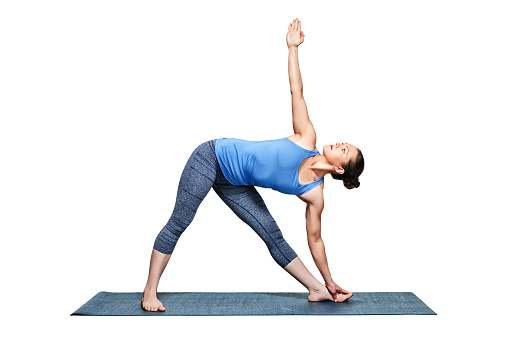
Stand upright. Stretch out to a distance greater than shoulder width. The foot of one leg is turned out, the other remains flat.
Push up, i.e. raise both arms to a horizontal position.
Stabilise with feet firmly on the ground. Slowly begin to lean sideways with the whole torso, arms crossed, towards the leg whose foot is pointing outwards.
All the time our legs are extended.
Try to touch the ankle or yoga aid. If that doesn't work, feel free to just use a stool.
Later we can switch sides.
In this position we practice body balance and the back and inner thighs.
Setu bandha sarvangasana - bridge
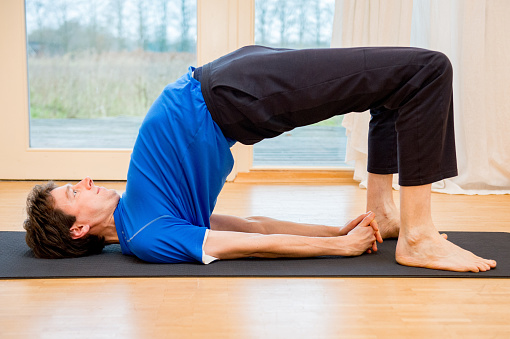
Lie on your back. Bend your legs at the knees so that your shins are perpendicular to the mat.
The feet are shoulder-width apart. Their entire surface touches the ground. Place the hands beside the body.
Lean on your shoulders and slowly lift your pelvis off the ground as high as possible. You can bring your hands together under your torso.
This position helps with mental problems and improves digestion.
In this article you will learn more about depression.
Savasana - the corpse position
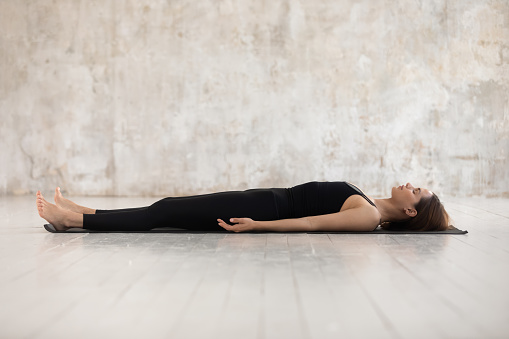
We take the position lying on our back. Our legs are slightly spread. Our feet are relaxed and our hands are turned palms up.
We close our eyes and try to feel the whole body. We start from the bottom to the top of the head.
Yoga and its effects
Yoga has beneficial effects especially against psychogenic illnesses.
We ourselves may not even perceive that there are any diseases involved.
They are caused by our bad attitude towards life and things around us. For example, negative thinking, stressful situations, disharmony in interpersonal relationships.
By practicing yoga we can eliminate or prevent these disorders.
Different body postures act on the endocrine glands. This promotes the production of different hormones.
Breathing exercises have a beneficial effect on the entire cardiovascular system and metabolism.
Effects of Yoga:
- Beneficial effect on health
- development of concentration
- helps in gaining self-confidence
- maintains physical and mental integrity
- keeps daily activities in harmony
- helps to overcome addictions, habits and attachments
- facilitates self-realisation
Read also the article on how to get rid of stress.
Interesting resources
Related

Bc. Radoslav Pleško
Healthcare worker
He graduated from the Bachelor's degree in Urgent Health Care at the Charles University in Nitra. Since 2006 he has been working in the emergency medical service. He is a 2nd level fitness trainer.
View all articles by the same authorThe aim of the portal and content is not to replace professional
examination. The content is for informational and non-binding purposes
only, not advisory. In case of health problems, we recommend seeking
professional help, visiting or contacting a doctor or pharmacist.









